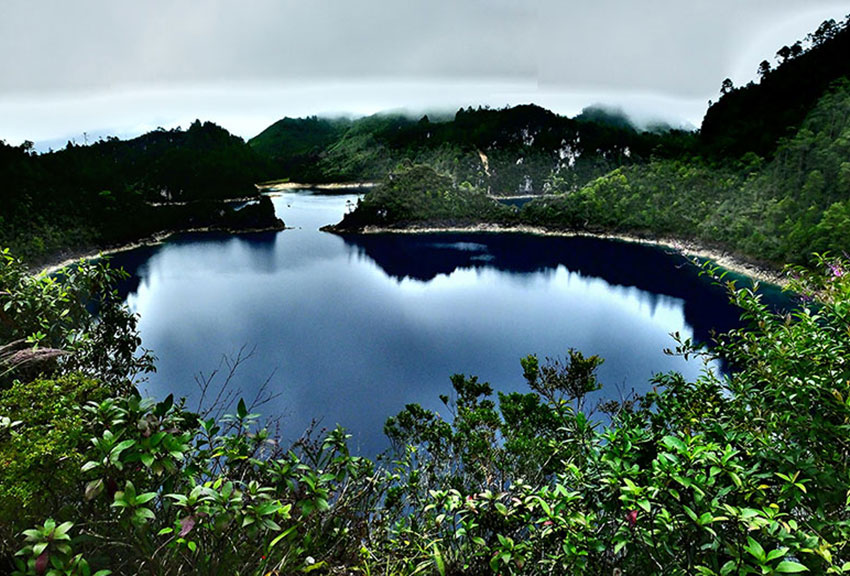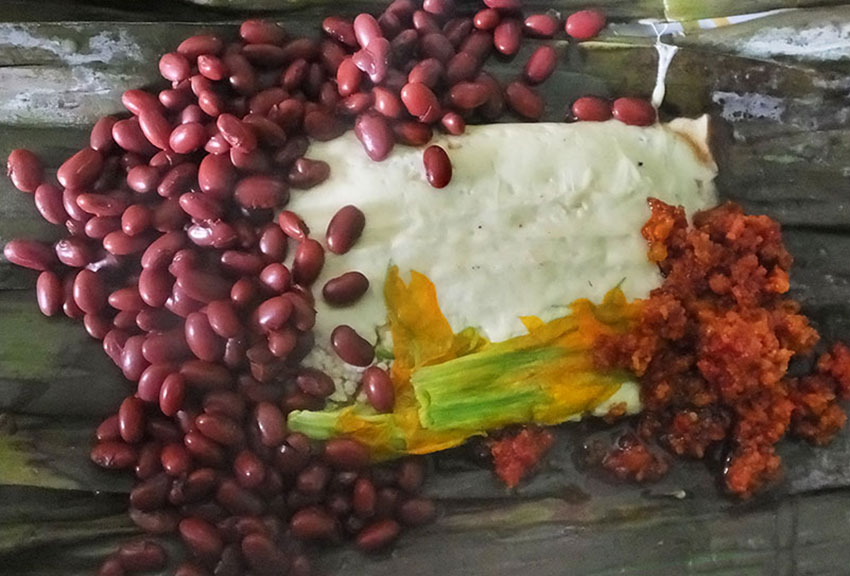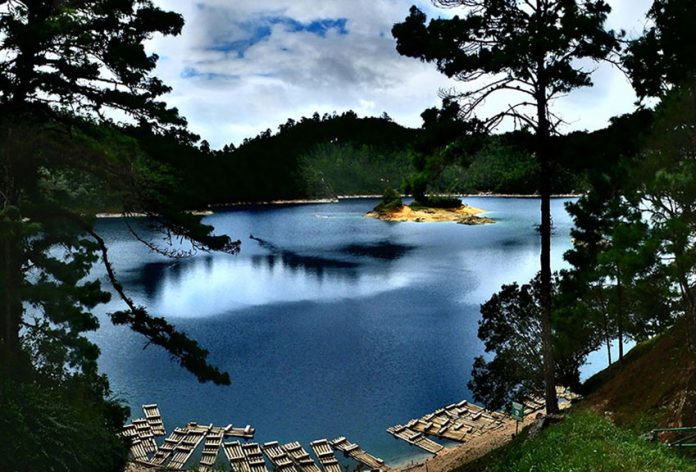While in Tuxtla, the capital of the state of Chiapas, I had a brief chance to visit the celebrated Lagunas de Montebello, which are located 170 kilometers to the southwest, near the border of Guatemala. This lake area is a Mexican national park and was designated a biosphere reserve by UNESCO in 2009.
No sooner had we passed Tuxtla’s city limits than we found ourselves and the highway entirely enveloped in thick fog. We really couldn’t see anything more than two meters ahead of us. I fully expected our driver and guide, Gabino, to pull off the road and wait for the fog to lift. But we just kept going, visibility almost zero.
“Don’t worry,” he said, “every time I come by here, it looks exactly like this. We’re all used to it.”
The further we drove, the higher we rose in altitude. “Oye, Gabino,” I asked, “will we pass any of those communities here in Chiapas with big signs saying ‘The Mexican government is not welcome around here?’”
“Bueno,” grinned Gabino, “you mean anuncios like that one right in front of us?”

Sure enough, we were just passing a sign announcing that we had arrived at the Zapatista Center for Independent Resistance and Rebellion at a place called Tulan Ka’u, which means Caballo Fuerte, Strong Horse.
Another sign gave us a big welcome to a kind of Zapatista roadside restaurant offering tacos and local dishes, “open to the general public.” The word BIENVENID@S was written with the “at” symbol, a convention adopted by the Zapatistas to signify their commitment to gender equality.
Curious, we parked and — the air still heavy with fog — walked over to a rustic dining hall of sorts, without walls, but protected by a long roof. Here ladies wearing warm scarves were cooking delicious-looking shrimp on a comal. I noticed that quite a few of the people present were wearing bandanas over their faces, but whether this was for warmth, concealment or just part of the Zapatista “uniform,” I’m not sure.
We had already breakfasted, but when we spotted the homemade tortillas they were preparing, we couldn’t resist: “Could we please have six of your delicious-looking tortillas,” we asked.
“Of course,” replied a jolly-looking woman. “But you’ll enjoy them much more with a shrimp — try a few!”
“Muchas gracias, but we just had breakfast — still, we can’t resist trying your tortillas.”

Both the shrimp and the tortillas were indeed as delicious as they looked, but when we tried to pay for them, the woman adamantly refused. “No, no! We’re just happy to see how much you like our tortillas. Vayan con Diós.”
Now that we felt somewhat integrated into the local community, we drove on until we reached the first lake Gabino planned to show us. A 20-minute hike up a steep, rocky and very muddy trail brought us to Cenote Bartolo. While certain members of our party were none too happy about getting their shoes full of mud, I was delighted, as I had never seen a cenote before — and I was wearing hiking boots.
Bartolo, like so many of the lakes in this area, is surrounded by high walls that make it look something like a crater. But, of course, this area is not volcanic. The rock here is limestone and the lakes are spots where the limestone has been eroded, giving access to the water beneath the surface.
While Bartolo’s waters had none of the subtle shades of color that make the lagoons of Montebello famous, I realized that many of a cenote’s attractions are underwater and can only be appreciated by cave divers. Several of my speleologist friends are in the process of studying and mapping the vast network of cave passages linking Mexico’s cenotes together.
So many of these networks have been found to be interconnected that southern Mexico’s vast collection of cenotes is already recognized as the second-longest cave system in the world with a present-day length of 372 kilometers (231 miles). While this is still well behind the world’s longest, the Mammoth Cave System (668 kilometers – 415 miles), cave explorers of Mexico are convinced it’s only a matter of time before Mammoth will be in second place.
From Bartolo, we went on to visit a few of the famous lagunas of the area: Tziscao, La Cañada, Pojoj, Montebello, Cinco Lagos and little Lago Internacional, which Mexico shares with Guatemala. These lakes are strikingly beautiful, with colors ranging from turquoise to purple. The many hues are said to be caused by the mineral content of the water, the sediment at the bottom, the surrounding vegetation and light refraction. As for the number of lakes in the area, the Chiapas Secretariat of Tourism says that no one really knows how many there are, but 59 is the standard number given to statistics-hungry tourists.
[soliloquy id="97621"]
Apart from gazing upon the beauty of these lakes from miradores or lookout points, you can also go rafting or kayaking on some of them. One of the most popular lakes for doing this is Lago Pojoj, which has an island in the middle of it with a small orchid and bromeliad garden. “Raft” in Spanish is balsa and the amazingly buoyant rafts at Lago Pojoj are actually made of balsa wood, which is native to the area and obviously useful for something more than making model airplanes.
Other local activities include horseback riding, hiking and the simple act of crossing the border at Lago Internacional where there are no fences, sniffer dogs or guards and no one asks for or even cares about passports: a truly unique experience, especially in these days of obsession with border walls.
Climbing down countless stairs to the shores of these lagoons — and then back up — is bound to give you an appetite. When we were good and hungry, we asked Gabino where he thought we should eat.
“I know just the place,” he replied, leading us into a small, cinderblock structure with three walls and no windows. Two cheerful local ladies welcomed us and, even though this restaurant had all the ambiance of a dungeon, their cheese fondue with pumpkin flowers and chorizo was spectacularly delicious and their chincunguajes (corn gorditas filled with red beans) were my first introduction to an authentic Chiapas dish. These delights, I should mention, we washed down with Gallo beer from Guatemala which, of course, was just down the road.
This excellent meal, enjoyed in the humblest of “restaurants” brought to a happy end my all too short visit to Chiapas. Five days offered me only a glimpse of this state, but that was enough to convince me that five years would probably not be enough even for the briefest introduction to this fascinating corner of Mexico.
The writer has lived near Guadalajara, Jalisco, for more than 30 years and is the author of A Guide to West Mexico’s Guachimontones and Surrounding Area and co-author of Outdoors in Western Mexico. More of his writing can be found on his website.
